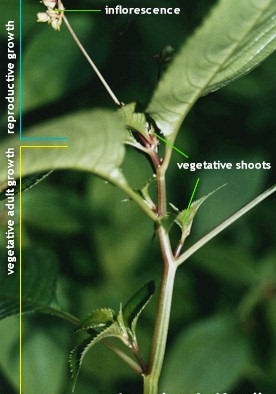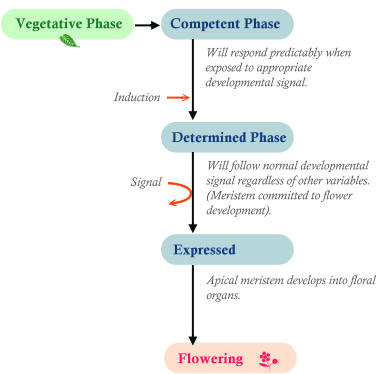Phase Changes
Like people and animals, plants pass through a series of well-defined developmental stages, each of which has a distinct effect on the individual plant. However, unlike in humans where the whole person undergoes the developmental change (for example from adolescence to adulthood), in plants only the shoot apical meristem undergoes these changes.
The shoot apical meristem is a collection of cells in the tip of a plant which have the capacity to develop into either vegetative (leaf) or reproductive (floral) organs and occasionally other organs such as roots and tendrils. Plant hormones affect what sort of tissue meristematic cells will develop into.
The shoot apical meristem (and therefore plants) undergo three distinct phases:
- Juvenile
- Adult vegetative
- Adult reproductive
Meristems in the juvenile phase have no ability to produce reproductive structures (cones or flowers) so are described as having no competence. Adult meristems are competent because they can now produce reproductive structures (ie. will respond to stimuli which trigger this), but the actual production of these will depend on environmental stimuli.
Juvenility cannot be confirmed solely by the absence of flowers. Following competency, a meristem must be "activated" and "committed" to flowering where a reversal to juvenility is not usually possible - such a meristem is said to be determined.

Phase change is often accompanied by changes in leaf morphology (structure) or other changes in the plant. Differences in juvenile and adult foliage can be seen in climbing fig (Ficus pumila), English ivy (Hedera helix) and some Eucalyptus and Acacia species where the juvenile leaves differ from the adult leaves. While the change from the adult vegetative to adult reproductive stages is abrupt, the change from juvenile to adult vegetative is slow and often results in intermediate forms where part of a plant will be juvenile while another part is mature. (This is because only the meristems change phase, so only the growth that results from the mature meristem will mature).
Phase change can be influenced by nutrients, hormones and other chemical and physical signals as well as genetics. Growing plants under low light has been found to prolong juvenility, or sometimes return plants to a state of juvenility if they have entered an adult phase.
Nutrient status is a measure of the concentration of nutrients available to a plant from the soil or potting medium and can have an effect on the likelihood of a plant flowering. In chrysanthemums (Dendranthema ×morifolium) the amount of nutrients available to a plant will affect how big the shoot apex becomes. If nutrients are limited, then the shoot apex will not grow big enough to allow floral primordia (the beginnings of a flower) to develop.
Another stimulant which can promote flowering in some plants is a hormone called gibberellic acid (GA3) which naturally occurs in all plants.
GA3 can be artificially synthesised. When juvenile plants are sprayed with GA3, floral organs can develop. However the application of GA3 to some plants has actually been found to cause a return to juvenility and so it appears that the response to gibberellic acid is species-specific and complex. Commercial growers sometimes use gibberellins to force flowering in some crops at a specific time; such as for chrysanthemums on Mothers' Day. (For more on this, go to Hormones).

In Figure 2 (above), a scheme is shown for tobacco (Tabacum sp.) where day length is the induction which will convert a competent meristem into a determined meristem. This means that the day length must be correct before a tobacco meristem which as become competent (able to produce a flower) to actually produce the flower. However, a further induction signal may be required before flower production is expressed.
In some cases, a determined flower will revert back to a vegetative state, and this is called floral reversion. Since floral reversion is not an influence on flowering, I have written a small piece on this phenomenon.
Next: Genetic Influences
